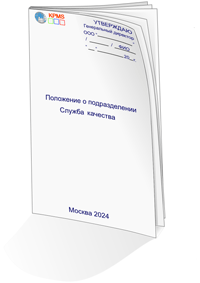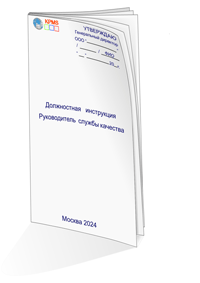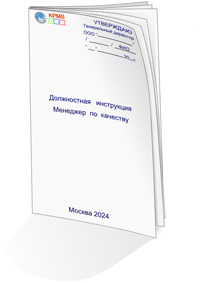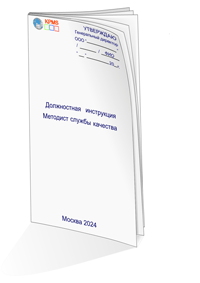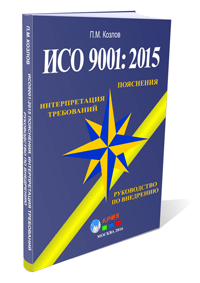The implementation of the quality system is a complex of works that affects various aspects of the organization's activities and its subsystems - the strategic management subsystem, the production subsystem, the logistics subsystem, personnel management, internal communications, document management, etc. The implementation of a quality system is quite a difficult and time-consuming task in this regard. The solution of this problem, as a rule, occurs in several stages.
Quality management system implementation
The main stages of Quality management system (QMS) implementation are as follows:
- the first stage is the analysis of the existing situation in the organization and staff training;
- the second stage is the development of documentation and changing the work of employees;
- the third stage is the internal audit of the quality system.
Each of these stages consists of a certain, rather large set of works. The most difficult and time-consuming stage is the second stage of work, but the first is the most critical for the entire QMS implementation project. Let's look at what needs to be done to develop and implement a quality system.
Analysis of the existing situation in the organization and staff training
The development and implementation of a quality system should be formalized as a project with its own goals, its own deadlines and its own resources. It is necessary to organize work on the project of implementing a quality system before starting an analysis of the existing situation. To do this, firstly, the top management of the organization should be willing and able to administratively support the quality system project, and secondly, it should allocate resources for this project.
The work of the first stage consists of the following main steps:
Step 1. An order is released for the company to start work on the quality system.
It is specified in the order:
purpose of work starting;
responsible person for the quality system from the top management of the organization;
the structure of the workgroup on the implementation of the quality system.
You need to pay attention to the following points when performing this step:
1. It is necessary to take into account that responsible person has real authority sufficient to influence the heads of any departments of the organization and has free time to monitor the progress of the project.
2. The structure of the workgroup directly dealing with the quality system should be no more than 5-7 people.
The group may look like this for a small enterprise (up to 100 people):
The head of the group is the head of the quality service of the organization (must devote at least 50% of the working time to the creation of a quality system and better when 100%). He may also be the only employee of this service;
The participants of the workgroup are key employees of departments. They know how the department works (they must devote at least 5-10% of their working time to create a quality system in addition to their main work).
For a large enterprise:
The head of the group is the head of the quality service of the organization, which devotes 100% of his working time to quality system;
The group members are employees of the quality service, which devote 100% of their time to create a quality system.
Representatives of the quality system are not member of the workgroup, but perform the tasks of the head and members of the workgroup. Representatives of the quality system are employees of the organization's departments. One employee from each department is needed for the normal organization of work. They should devote 5-10% of their working time to create a quality system in their department in addition to their main work.
Step 2. It is training of the workgroup members in quality management and the requirements of ISO 9000 series standards. The head of the workgroup and its members must be necessarily trained, because the analysis of the current state of affairs and the development of a quality system will be their main task.
Step 3. It is necessary to analyze the current situation in order to understand how much the existing activity in the organization differs from the requirements of the ISO 9001 standard. The collection of initial data is carried out mainly by two methods - a questionnaire and an interview. It is most effective to use both methods, first conduct a survey, and then clarify the necessary information during conversations with employees. The members of the workgroup are responsible for the survey and interviews.
Of course, you cannot do all this, but in this case, the members of the workgroup should conduct such analysis based on their knowledge of the work of the departments.
The result of the analysis may be a report or other document. It will be indicated how ISO 9001 requirements are implemented and what is the degree of implementation of this requirement in various departments of the organization.
The analysis of the current situation should detect:
the main production processes of the organization;
secondary and support processes;
the most critical business processes from the point of view of the quality system;
availability and relevance of regulatory documentation (enterprise standards, instructions, regulations on divisions, job descriptions, etc.);
the existing distribution of responsibilities, powers and resources across the organization's processes.
Development of documentation and changing the work of employees
This stage is the most time-consuming and lengthy. The design, development and implementation of quality system documentation are carried out during this stage, as well as the introductions of changes in the working order of employees are made.
The actions of the second stage consist of the following main steps:
Step 1. It is necessary to plan how the quality system will be create, what will be the scope of its application, what processes will enter the quality system, how it will expand. For example, an organization provides its customers with several types of different services. These services are provided by various departments. It may be decided to initially include in the scope of the quality system only the processes and departments involved in the provision of a single service at the first stage. Processes and departments involved in the provision of other services may be include into scope of quality system later. This can be done after the quality system is fully operational for the first service. The construction of a quality system will take place on the principle of increasing the scope of its distribution in this case.
Step 2. The main principles of the ISO 9001 standard are the process approach. The standard requires defining and documenting the organization's processes in order to implement a process approach. The workgroup must first formalize the processes that have been included in the scope of the quality system as they are in order to fulfill this requirement. Then it makes changes to these processes in accordance with the requirements specified in the standard.
You need to pay attention to the following points when performing this step:
The implementation of a quality system is associated with the management of changes in the organization's activities. The execution of any changes always affects the interests of the employees related by these changes. As a result, people either resist change or support it. A neutral attitude is rare. Administrative support from the top management of the organization is necessary (to reduce the resistance level) in order to be able to effectively carry out process changes and getting fast enough results from changes (to maintain support, from those who accept the changes). It is necessary to correctly determine the procedure for documenting and changing processes in order to implement this principle. First of all, it is recommended to formalize and adjust the most important processes.
Step 3. Quality management system procedures are documented and implemented.
The ISO 9001 standard requires that the organization's processes are defined and documented. Process documentation can be performed in the form of process maps, which indicate the order of process operations, input and output data (information, resources) of each operation and people responsible for performing the operation. Documenting of processes as the form of process maps significantly reduces the amount of documentation. In addition, it is important to maintain a balance in the detail of the presentation of the process when documenting processes. The process should be presented with such a degree of detail that the personnel involved in the process can understand the order of the process operations and determine their "place" in this process.
In accordance with the requirements of the standard the organization shall develop documents, determined by the organization to be necessary to ensure the effective planning, operation and control of its processes (process maps, regulations, instructions).
It is better to implement quality system process maps and procedures in parallel with their development. It is necessary to put process map into effect as soon as it was developed and changes to the process was made.
The introduction of procedures and new process maps should be accompanied by staff training and monitoring of execution of the procedure (process map).
It is necessary for the organization to work on maps and procedures for a certain period of time after all the process maps and procedures of the quality system have been developed. This time is necessary to "adjust" the quality system. Minor changes to the documentation of the quality system are usually carried out during this period.
Internal audit of the quality system
The main purpose of this stage is to check the work of the quality system of the enterprise before the certification audit. Additional objectives of this stage will be – practical training of internal auditors to conduct audits, training of the organization's personnel before the certification audit.
The actions of this stage consist of the following main steps:
Step 1. An internal audit of the quality system must be prepared and planned.
You need:
A team of auditors (lead auditor and auditors) must be officially appointed (by order of the organization). The team of auditors is appointed among the employees trained to conduct internal audits;
It is necessary to prepare a plan and program for conducting an audit in the divisions. The plan and schedule of the internal audit should include all departments of the enterprise whose activities are the scope of the quality system;
You need to prepare questionnaires for the audit;
An order about of the audit execution must be released.
Step 2. Audit interviews are conducted. Auditors check the work of the organization's employees in accordance with the process maps and procedures of the quality system. The audit is conducted according to the audit program. If nonconformities are found during the audit, the auditors should draw up nonconformity registration protocols, which indicate the identified nonconformities. Auditors check the availability of quality system documentation at the workplace, work on this documentation, documented information that required by the system.
Step 3. It is preparation of the audit report and corrective action plan. The lead auditor must prepare an audit report. It indicates the scope of the audit, the requirements for which the audit was conducted and statistics on the identified nonconformities. This report is prepared after completion of the audit of divisions and registration of all protocols of registration of nonconformities. The audit report must be signed by the lead auditor and presented to the top management of the organization (for example, the general manager).
The lead auditor should prepare a plan of corrective actions to correct the identified nonconformance. This plan is prepared together with members (managers) of the departments in which nonconformance have been identified. Responsibility for the implementation of corrective actions specified in the plan should be assigned to members (managers) of departments in which nonconformance has been identified. Auditors should not be responsible for the identified nonconformance.
The members of the divisions must inform the lead auditor about the elimination of nonconformance after the corrective actions have been made. The lead auditor or the auditors of the internal audit team should check the effectiveness of the actions. If corrective actions have indeed been performed, then the lead auditor or auditors make notes on the completion of corrective actions in the protocols of registration of nonconformance and in the plan of corrective actions.
The organization can apply to the certification body for certification according to ISO 9001 when all corrective actions are completed.
After the organization successfully passes certification and receives a certificate of compliance with ISO 9001 requirements, the work on the quality system does not end there, although their volume may already be less. The quality system must be maintained and must be continuously improved. This means that any changes in the organization's products (services), processes or in the system itself must be promptly analyzed and recorded in the quality system documentation.
The organization must conduct periodic internal audits in order to confirm the effectiveness and efficiency of the quality system. Such audits should be conducted in the organization at least as often as supervisory audits by the certification body will take place. As a rule, supervisory audits by the certification body are conducted once a year.
An example of the “Regulations on the Quality Service” and “Job descriptions of key employees” can be viewed and purchased in the "Quality Management" online store.
Regulations on the Quality Service
The Regulation on the Quality Service is one of the fundamental documents regulating the work of the unit.
This provision defines the main tasks, functions and rights of the quality service.
Tasks, functions and rights have a direct relationship. The list of the necessary functions and rights are defined for each task of the quality service. They allow solving the task and performing the functions of the unit.
The regulation can be applied in organizations of various fields of activity.
The regulation is compiled on the basis of information on the "KPMS" Company.
The document includes 7 pages.
The document format is pdf.
Job description of the head of the quality service
The "Job description of the Head of the quality service" is a document regulating the tasks, job responsibilities, rights, interactions and responsibilities of one of the key person of the quality system. This job description can be applied in organizations of various fields of activity.
The "Job description of the Head of the quality service" was developed on the basis of information on the "KPMS" Company.
The document includes 7 pages.
The document format is pdf.
Job description of the quality manager
The "Job description of a Quality Manager" is a document regulating the tasks, job responsibilities and rights of a quality service employee. The job description is based on the principle of a cross-cutting relationship of tasks, responsibilities and rights. A set of job responsibilities for each task solved by a quality manager is specified that allow you to complete the task. A set of rights for the implementation of responsibility that are necessary for the performance of assigned duties is specified.
The job description of the quality manager is developed on the basis of information on the "KPMS" Company.
The document includes 6 pages.
The document format is pdf.
Job description of the quality service methodologist
A quality service methodologist is a specific position in the quality system of an organization. The main task of the quality service methodologist is to organize and provide methodological support for the implementation, operation and development of the quality system.
The "Job description of the quality service methodologist" defines the range of main tasks, responsibilities and rights of this position.
The job description of the quality service methodologist was developed on the basis of information on the "KPMS" Company.
The document includes 5 pages.
The document format is pdf.
